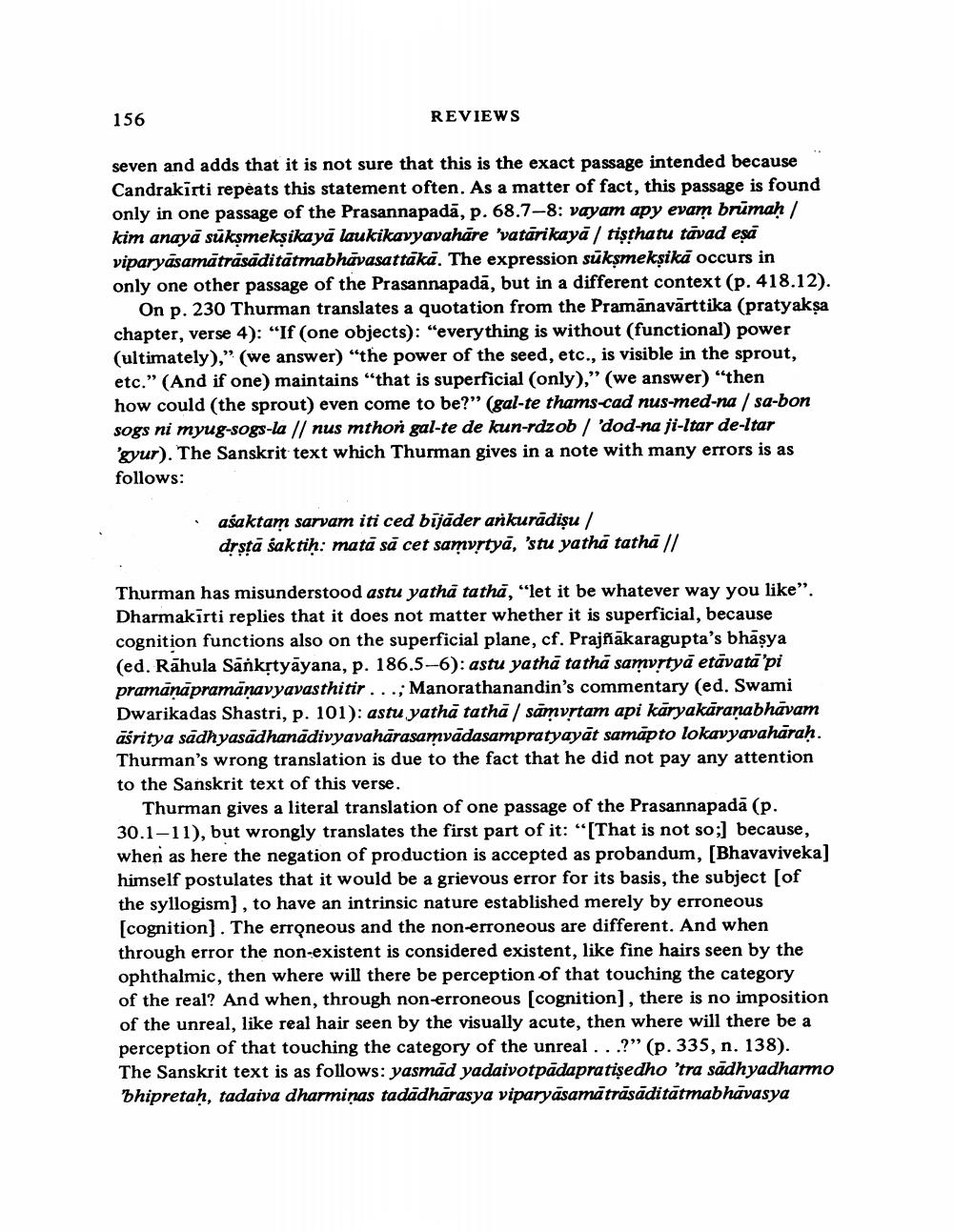________________
156
REVIEWS
seven and adds that it is not sure that this is the exact passage intended because Candrakirti repeats this statement often. As a matter of fact, this passage is found only in one passage of the Prasannapadā, p. 68.7-8: vayam apy evam brūmah / kim anayā sūksmekşikayā laukikavyavahāre 'vatārikayā / tişthatu tāvad esa viparyāsamātrāsāditātmabhāvasattaka. The expression sūksmekșikā occurs in only one other passage of the Prasannapadā, but in a different context (p. 418.12).
On p. 230 Thurman translates a quotation from the Pramanavārttika (pratyaksa chapter, verse 4): “If (one objects): "everything is without (functional) power (ultimately)," (we answer) “the power of the seed, etc., is visible in the sprout, etc." (And if one) maintains that is superficial (only)," (we answer) "then how could (the sprout) even come to be?" (gal-te thars-cad nus-med-na / sa-bon sogs ni myug-sogs-la // nus mthon gal-te de kun-rdzob / 'dod-na ji-ltar de-Itar 'gyur). The Sanskrit text which Thurman gives in a note with many errors is as follows:
asaktam sarvam iti ced bijāder arkurădişu / drstā saktiņ: matā să cet samvrtya, 'stu yatha tatha //
Thurman has misunderstood astu yatha tatha, "let it be whatever way you like". Dharmakirti replies that it does not matter whether it is superficial, because cognition functions also on the superficial plane, cf. Prajstākaragupta's bhāşya (ed. Rāhula Sankstyāyana, p. 186.5-6): astu yathā tathā samyrtyā etāvata 'pi pramanāpramanavyavasthitir ...,Manorathanandin's commentary (ed. Swami Dwarikadas Shastri, p. 101): astu yathā tathā / samvrtam api kāryakaranabhāvam asritya sādhyasādhanādivyavahārasamvādasampratyayāt samapto lokavyavahāraḥ. Thurman's wrong translation is due to the fact that he did not pay any attention to the Sanskrit text of this verse.
Thurman gives a literal translation of one passage of the Prasannapadā (p. 30.1-11), but wrongly translates the first part of it: "[That is not so;] because, when as here the negation of production is accepted as probandum, [Bhavaviveka] himself postulates that it would be a grievous error for its basis, the subject [of the syllogism), to have an intrinsic nature established merely by erroneous [cognition). The erroneous and the non-erroneous are different. And when through error the non-existent is considered existent, like fine hairs seen by the ophthalmic, then where will there be perception of that touching the category of the real? And when, through non-erroneous (cognition), there is no imposition of the unreal, like real hair seen by the visually acute, then where will there be a perception of that touching the category of the unreal ...?” (p. 335, n. 138). The Sanskrit text is as follows: yasmad yadaivotpädapratiședho 'tra sādhyadharmo bhipretaḥ, tadaiva dharminas tadădhārasya viparyāsamā trāsāditātmabhāvasya




